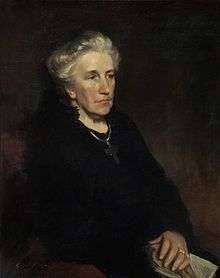Louise Creighton

Louise Hume Creighton, née von Glehn (7 July 1850 – 15 April 1936) was a British author of books on historical and sociopolitical topics, and an activist for a greater representation of women in society, including women's suffrage, and in the Church of England.[1]
Early life
Louise was born at Peak Hill Lodge in Sydenham on 7 July 1850. She was one of the younger daughters of Robert von Glehn, a City of London merchant, and his wife, Agnes Duncan. Her older brother was Alfred de Glehn, the designer of the French steam locomotive engine. She was homeschooled before she passed, with honours, the first London University higher examination for women. She was a prolific reader and a keen student of both the writings of John Ruskin and the Whigs historian John Richard Green.
Marriage to Mandell Creighton
In 1872, Louise married Mandell Creighton, an University of Oxford-educated historian who later became a University of Cambridge Professor in ecclesiastical history, and was appointed Church of England bishop of Peterborough, in 1891, and London, in 1897. The couple had seven children: Beatrice in 1872, Lucia in 1874, Cuthbert in 1876, Walter in 1878, Mary in 1880, and Oswin in 1883; and finally Gemma, born in 1887.[2]
Women's rights advocacy
In 1885, Louise founded the National Union of Women Workers with Lady Laura Ridding and Emily Janes. Although it was called a union, its purpose was to co-ordinate the voluntary efforts of women across Great Britain.[3] It said that it would "promote sympathy of thought and purpose among the women of Great Britain and Ireland"[4] Creighton was its first president.
Creighton was a popular author, particularly of historical biographies and stories for children including the successful "Child's First History of England".
Later career

After the death of her husband in 1901, Creighton became an influential advocate for women's suffrage and social reform. As well as writing and editing books, she served on two Royal Commissions and the Joint Committee of Insurance Commissioners.
As a member of the Standing Committee of the Society for the Propagation of the Gospel, she helped promote the work of women missionaries and took a leading role chairing the women's meetings at the Pan-Anglican Congress of 1908.
After nearly twenty years living in a grace-and-favour apartment at Hampton Court Palace, Creighton moved back to Oxford in the late 1920s, and subsequently served on the governing board of Lady Margaret Hall. After a period of declining health, she died on 15 April 1936, and her cremated remains were buried in St. Paul's Cathedral, London in the grave of her husband.
See also
Notes
- ↑ Covert 2000, pp. 67–72, Covert 2000, pp. 295–317
- ↑ Covert 2000, pp. 83–126
- ↑ Serena Kelly, ‘Ridding , Lady Laura Elizabeth (1849–1939)’, Oxford Dictionary of National Biography, Oxford University Press, 2004 accessed 22 Nov 2017
- ↑ "Socities Which Help Women And Children. No. 1. The National Union Of Woman Workers". chestofbooks.com. Retrieved 2017-11-22.
References
- Covert, James (2000), A Victorian Marriage: Mandell and Louise Creighton, London and New York: Hambledon and London. Pp. xv, 412, 35 plates, ISBN 1-85285-260-7
- Covert, James Thayne (2004), "Louise Hume Creighton (1850–1936)", in Matthew, H. C. G.; Harrison, Brian, Oxford Dictionary of National Biography, Oxford: Oxford University Press, doi:10.1093/ref:odnb/38640
External links
- Works by Louise Creighton at Project Gutenberg
- Works by or about Louise Creighton at Internet Archive
| Non-profit organization positions | ||
|---|---|---|
| Preceded by New position |
President of the National Union of Women Workers 1895–1897 |
Succeeded by Mrs Alfred Booth |